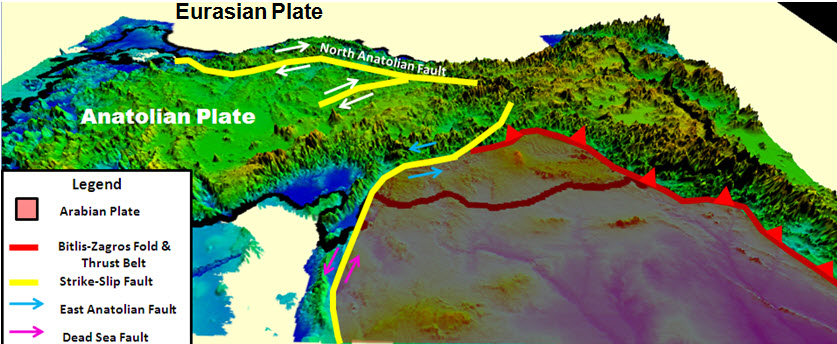Eurasian Plate on:
[Wikipedia]
[Google]
[Amazon]
The Eurasian Plate is a  The geodynamics of
The geodynamics of
tectonic plate
Plate tectonics (from the la, label=Late Latin, tectonicus, from the grc, τεκτονικός, lit=pertaining to building) is the generally accepted scientific theory that considers the Earth's lithosphere to comprise a number of large te ...
that includes most of the continent of Eurasia
Eurasia (, ) is the largest continental area on Earth, comprising all of Europe and Asia. Primarily in the Northern and Eastern Hemispheres, it spans from the British Isles and the Iberian Peninsula in the west to the Japanese archipelago ...
(a landmass consisting of the traditional continent
A continent is any of several large landmasses. Generally identified by convention rather than any strict criteria, up to seven geographical regions
In geography, regions, otherwise referred to as zones, lands or territories, are areas t ...
s of Europe
Europe is a large peninsula conventionally considered a continent in its own right because of its great physical size and the weight of its history and traditions. Europe is also considered a subcontinent of Eurasia and it is located entirel ...
and Asia
Asia (, ) is one of the world's most notable geographical regions, which is either considered a continent in its own right or a subcontinent of Eurasia, which shares the continental landmass of Afro-Eurasia with Africa. Asia covers an are ...
), with the notable exceptions of the Indian subcontinent
The Indian subcontinent is a list of the physiographic regions of the world, physiographical region in United Nations geoscheme for Asia#Southern Asia, Southern Asia. It is situated on the Indian Plate, projecting southwards into the Indian O ...
, the Arabian subcontinent and the area east of the Chersky Range in eastern Siberia
Siberia ( ; rus, Сибирь, r=Sibir', p=sʲɪˈbʲirʲ, a=Ru-Сибирь.ogg) is an extensive region, geographical region, constituting all of North Asia, from the Ural Mountains in the west to the Pacific Ocean in the east. It has been a ...
. It also includes oceanic crust extending westward to the Mid-Atlantic Ridge and northward to the Gakkel Ridge.
The eastern edge is a boundary with the North American Plate to the north and a boundary with the Philippine Sea Plate to the south and possibly with the Okhotsk Plate and the Amurian Plate. The southern edge is a boundary with the African Plate
The African Plate is a major tectonic plate that includes much of the continent of Africa (except for its easternmost part) and the adjacent oceanic crust to the west and south. It is bounded by the North American Plate and South American Plate ...
to the west, the Arabian Plate
The Arabian Plate is a minor tectonic plate in the Northern and Eastern Hemispheres.
It is one of the three continental plates (along with the African and the Indian Plates) that have been moving northward in geological history and colliding ...
in the middle and the Indo-Australian Plate to the east. The western edge is a divergent boundary with the North American Plate forming the northernmost part of the Mid-Atlantic Ridge, which is straddled by Iceland
Iceland ( is, Ísland; ) is a Nordic island country in the North Atlantic Ocean and in the Arctic Ocean. Iceland is the most sparsely populated country in Europe. Iceland's capital and largest city is Reykjavík, which (along with its s ...
. All volcanic eruptions in Iceland, such as the 1973 eruption of Eldfell, the 1783 eruption of Laki and the 2010 eruption of Eyjafjallajökull
Eyjafjallajökull (; ), sometimes referred to by the numeronym E15, is one of the smaller ice caps of Iceland, north of Skógar and west of Mýrdalsjökull. The ice cap covers the caldera of a volcano with a summit elevation of . The volcan ...
, are caused by the North American and the Eurasian Plates moving apart, which is a result of divergent plate boundary forces. The Himalayan mountain range and Tibetan plateau have formed as a result of the collision between the Indian Plate and the Eurasian Plate, which began 50 million years ago and continues today.
 The geodynamics of
The geodynamics of Central Asia
Central Asia, also known as Middle Asia, is a subregion, region of Asia that stretches from the Caspian Sea in the west to western China and Mongolia in the east, and from Afghanistan and Iran in the south to Russia in the north. It includes t ...
is dominated by the interaction between the Eurasian Plate and the Indian Plate. In this area, many subplates or crust blocks have been recognized, which form the Central Asian and the East Asian transit zones."Up-to-Date Geodynamics and Seismicity of Central Asia" by Y. Gatinsky, D. Rundquist, G. Vladova, T. Prokhodova
See also
* Sunda Plate * Anatolian Plate * Aegean Sea Plate *References
{{Indochina plates Tectonic plates Geology of Asia Geology of Europe Geology of Iceland Geology of the Pacific Ocean Geology of the Atlantic Ocean